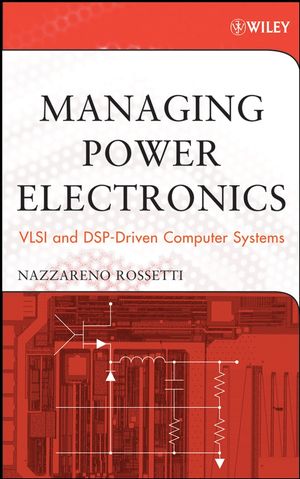Managing Power Electronics: VLSI and DSP-Driven Computer SystemsISBN: 978-0-471-70959-6
Hardcover
408 pages
November 2005, Wiley-IEEE Press
 This is a Print-on-Demand title. It will be printed specifically to fill your order. Please allow an additional 10-15 days delivery time. The book is not returnable.
|
||||||
Preface.
1. Introduction.
1.1 Technology Landscape.
1.2 A Young Industry after All.
2. Power Management Technologies.
2.1 Introduction.
2.2 Integrated Circuits Power Technology: Processing and Packaging.
Diodes and Bipolar Transistors.
Metal-Oxide-Semiconductor (MOS) Transistors.
DMOS Transistors.
CMOS Transistors.
Passive Components.
A Monolithic Process Example.
Packaging.
2.3 Discrete Power Technology: Processing and Packaging.
From Wall to Board.
Power MOSFET Technology Basics.
Package Technologies.
2.4 Ongoing Trends.
3. Circuits.
PART I. ANALOG CIRCUITS.
3.1 Transistors.
NPN.
PNP.
Trans-Conductance.
Transistor as Transfer-Resistor.
Transistor Equations.
MOS versus Bipolar Transistors.
3.2 Elementary Circuits.
Current Mirror.
Current Source.
Differential Input Stage.
Differential to Single Input Stage.
Buffer.
3.3 Operational Amplifier (Opamp).
Inverting and Non-Inverting Inputs.
Rail to Rail Output Operation.
CMOS Opamp.
Opamp Symbol and Configurations.
DC Open Loop Gain.
AC Open Loop Gain.
3.4 Voltage Reference.
Positive TC of ?VBE.
Negative TC of VBE.
Build a ?VBE.
Building a Voltage Reference.
Fractional Band-Gap Voltage Reference.
3.5 Voltage Regulator.
3.6 Linear versus Switching.
3.7 Switching Regulators.
3.8 Buck Converters.
Switching Regulator Power Train.
Output Capacitor.
Electrolytic Capacitors and Transient Response.
Ceramic Capacitors.
Losses in the Power Train.
The Analog Modulator.
Driver.
Switching Regulator Block Diagram.
Switching Regulator Control Loop.
Input Filter.
Input Inductor LIN.
Input Capacitor.
Current Mode.
3.9 Flyback Converters.
PART II. DIGITAL CIRCUITS.
3.10 Logic Functions.
NAND Gate.
Set-Reset R Flip-Flop.
Current Mode with Anti-Bouncing Flip-Flop.
4. DC-DC Conversion Architectures.
4.1 Valley Control Architecture.
Peak and Valley Control Architectures.
Transient Response of Each System.
Valley Control with FAN5093.
Conclusion.
4.2 Monolithic Buck Converter.
A New Design Methodology for Faster Time to Market The Design Cycle.
The FAN5301.
The Behavioral Model.
Light Load Operation.
Full Load Operation.
Over-Current.
One Shot.
Comparator.
Results.
Timing.
Conclusion.
4.3 Active Clamp.
Introduction.
Application.
Test Results.
Comments.
4.4 Battery Charging Techniques: New Solutions for Notebook Battery Chargers.
High Efficiency.
The Smart Battery System.
Data Conversion.
Fast Charge.
Battery Charger System.
4.5 Digital Power.
Control Algorithm of Modern Switching Regulators: Analog or Digital?.
Fast Switchmode Regulators and Digital Control.
5. Offline (AC-DC) Architectures.
5.1 Offline Power Architectures.
Introduction.
Offline Control.
PFC Architecture.
DC-DC Conversion Down to Low Voltage.
Future Trends.
5.2 Power AC Adapter: Thermal and Electrical Design.
Introduction: The Challenge.
AC Adapter Power Dissipation.
AC Adapter Case Temperature.
Active and No-load Operation.
Development of a Solution.
Conclusion.
6. Power Management of Ultraportable Devices.
6.1 Power Management of Wireless Computing and Communications Devices.
The Wireless Landscape.
Power Management Technologies for Wireless.
Cellular Telephones.
Wireless Handheld.
Charge.
Protection and Fuel Gauging.
Convergence of Cellular Telephone and Handheld.
Future Architectures.
6.2 Power Management in Wireless Telephones: Subsystem Design Requirements.
Smart Phone Subsystems.
Display Board.
Keypad Board.
Main Board.
Battery Pack.
AC Adapter.
6.3 Powering Feature-Rich Handsets.
Growing Complexity and Shrinking Cycle Time.
Power Management Unit.
Low Dropouts (LDOs).
6.4 More on Power Management Units in Cell Phones.
Barriers to Up-Integration.
PMU Building Blocks.
CPU Regulator.
Low Dropout Block.
The Microcontroller.
The Microcontroller Die.
Processing Requirements.
Microcontroller-Driven Illumination System.
6.5 Color Displays and Cameras Increase Demand on Power Sources and Management.
Digital Still Camera.
Camera Phones.
Power Minimization.
Untethered Operation.
7. Computing and Communications Systems.
7.1 Power Management of Desktop and Notebook Computers.
Power Management System Solution for a Pentium III Desktop System.
Power Management System Solution for Pentium IV Systems (Desktop and Notebook).
Desktop Systems.
Powering the Silver Box.
Notebook Systems.
Future Power Trends.
7.2 Computing and Data Communications Converge at the Point of Load.
The Proliferation of Power Supplies.
Telecom Power Distribution.
Computing Power Distribution.
Multiphase Buck Converter for POLs and VRMs.
Conclusion.
7.3 Efficient Power Management ICs Tailored for DDR-SDRAM Memories.
Introduction.
DDR Power Management Architecture.
Worst Case Current Consumption.
Average Power Consumption.
Transient Operation.
Standby Operation.
Linear versus Switching.
Second Generation DDR-DDR2.
FAN5236 for DDR and DDR2 Memories.
Future Trends.
7.4 Power Management of Digital Set-Top Boxes.
Set-Top Box Architecture.
Power Management.
High Power Set-Top Boxes.
Low Power Set-Top Boxes.
Conclusion.
7.5 Power Conversion for the Data Communications Market.
Introduction.
Current Environment with Separate Networks.
Migration to Converged Voice/Data/Video IP.
Telecom -48 V DC Power Distribution.
Datacom AC Power Distribution.
Conclusion.
8. Future Directions and Special Topics.
8.1 Beyond Productivity and Toys: Designing ICs for the Health Care Market.
8.2 Power Management Protocols Help Save Energy.
ACPI.
Motherboard (DC-DC) Voltage Regulators.
Offline (AC-DC) Voltage Regulators with Power.
Factor Correction (PFC).
Green Power (Energy Management).
New Low Power System Requirements.
Conclusion.
8.3 Heat Disposal in Electronics Applications.
Active versus Passive Cooling.
Limits of Passive Cooling.
Active Cooling.
Active Cooling-Yes or No?.
Active Cooling Implementation.
8.4 Web Based Design Tools.
The Tools on the Web.
8.5 Motor Drivers for Portable Electronic Appliances.
Introduction.
Camera Basics.
Motors and Motor Drivers.
Driving Implementation.
Efficiency.
DSC Power Consumption.
Conclusion.
Appendix A.Fairchild Specifications for FAN5093.
Appendix B. Fairchild Specifications for FAN4803.
Appendix C. Fairchild Specifications for FSD210 and FSD200.
Appendix D. Fairchild Specifications for FAN5307.
Appendix E. Fairchild Specifications for ACE1502.
Appendix F. Fairchild Specifications for FAN5236.
Appendix G. Fairchild Specifications for FAN8702.
Glossary.
Further Reading.
Index.



